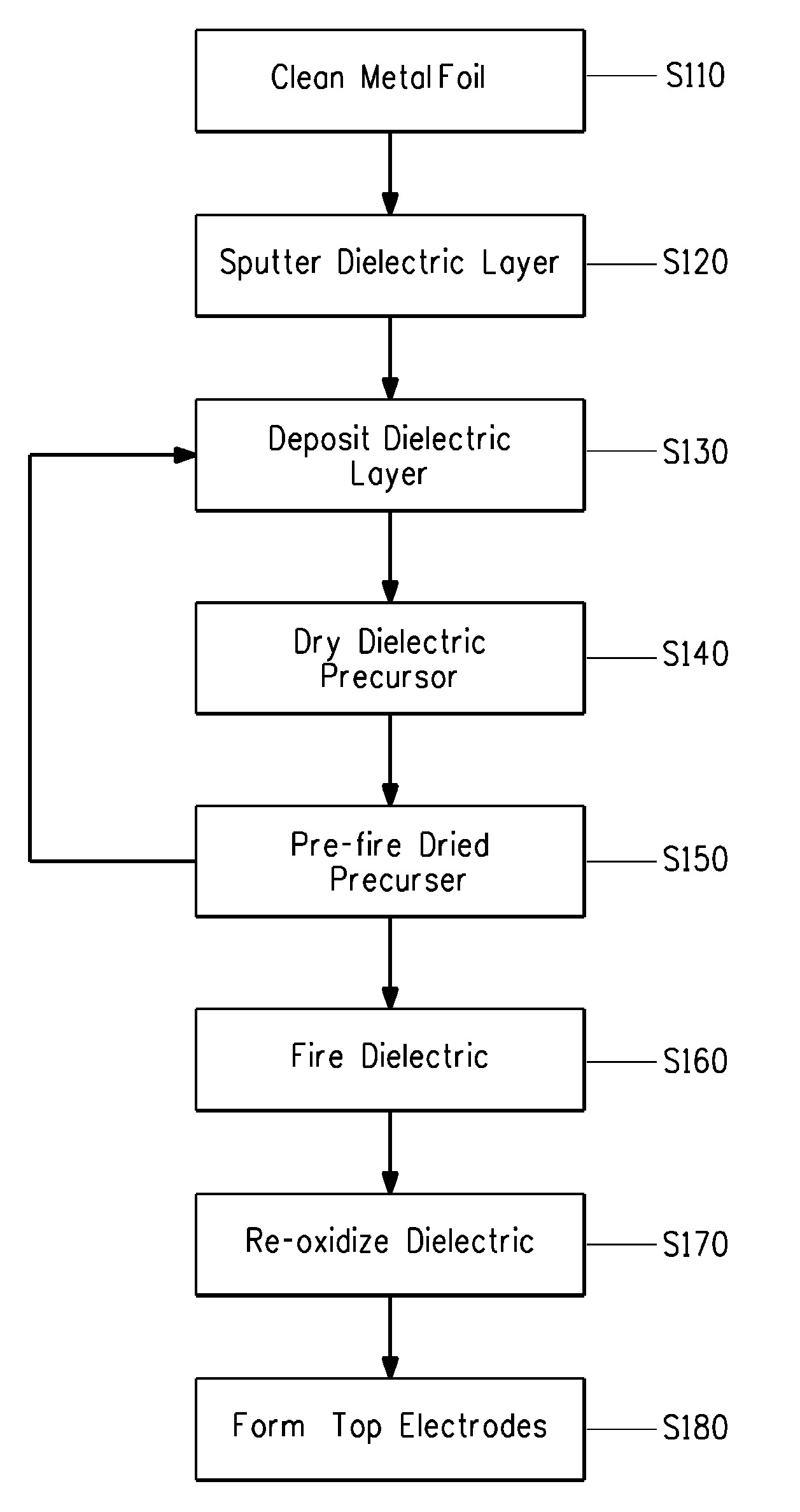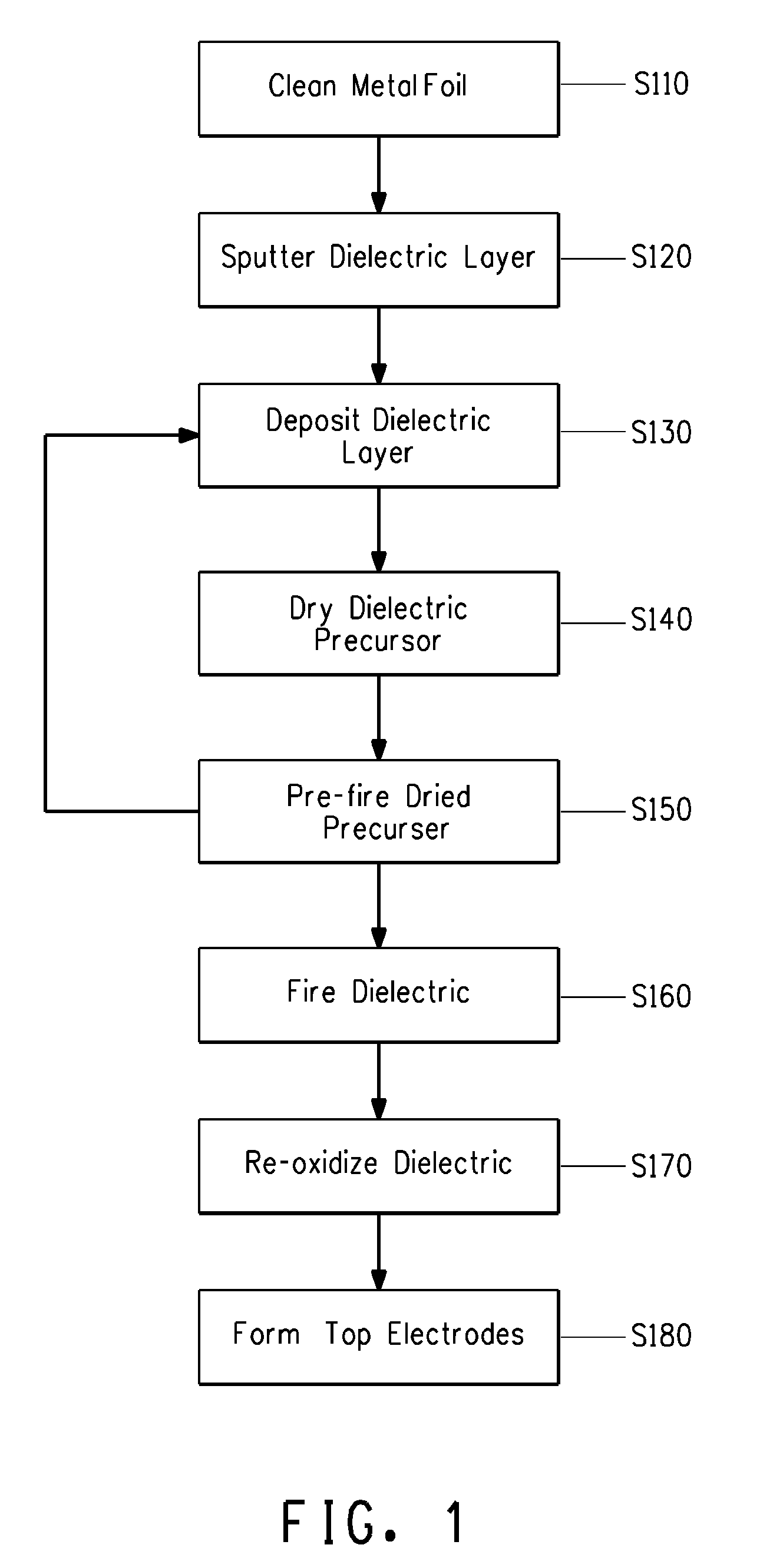Thin film capacitors on metal foils and methods of manufacturing same
a technology metal foils, applied in the field of thin film capacitors on metal foils, can solve the problems of low insulation resistance in barium titanate based compositions, inability to replace like conventional surface mounted capacitors, and troublesome achieving 100% embedded capacitor yield
- Summary
- Abstract
- Description
- Claims
- Application Information
AI Technical Summary
Benefits of technology
Problems solved by technology
Method used
Image
Examples
example 1
[0064]A barium strontium titanate (BST) first dielectric layer was sputtered on to the surface of nickel foil to a nominal thickness of 0.25 micrometer. The sputtering target was doped barium strontium titanate with a composition of Ba0.25Sr0.25Ti0.493528Mn0.0679Nb0.4Mg0.1793O3. The deposition was accomplished by radio frequency (RF) sputtering in argon using a deposition pressure of around 10 mtorr using an RF power of 200W. A nominal 0.4 mol (M) barium titanate dielectric precursor solution doped with a nominal 0.4 mole % manganese was spin-coated onto the sputtered BST first dielectric layer. The coating speed was 3000 rpm. The dielectric precursor solution was then dried in air for 7 minutes at 250° C. The dried dielectric precursor layer was then prefired for 10 minutes at 450° C. in a moist nitrogen / forming gas mixture that was created by bubbling a mixture of nitrogen and forming gas (99% nitrogen and 1% hydrogen) through a water bath at approximately 20° C. to create a gas a...
example 2
[0068]A barium strontium titanate first dielectric layer was sputtered on to the surface of nickel foil to a nominal thickness of 0.4 micrometers. The target composition and deposition conditions were as described in Example 1. A nominal 0.3 M barium titanate dielectric precursor solution doped with a nominal 0.4 mole % manganese was spin coated onto the sputtered BST first dielectric layer. The coating speed was 3000 rpm. The precursor solution was then dried in air for 7 minutes at 250° C. The dried precursor was then prefired for 20 minutes at 450° C. in air. The ramp rate of the furnace during the prefire heating phase was approximately 15° C. per minute. The same process of spin coating deposition, drying and prefiring at 450° C. in air was repeated 15 times to obtain the desired film thickness.
[0069]The multiple dried and prefired dielectric precursor layers, the sputtered BST first dielectric layer and the nickel foil were fired in a six inch internal diameter tube furnace at...
example 3
[0072]A barium strontium titanate first dielectric layer was sputtered on to the surface of nickel foil to a nominal thickness of 0.4 micrometers. The target composition and deposition conditions were as described in Example 1. The sputtered BST first dielectric layer and the Ni foil was then fired in a six inch internal diameter tube furnace at 900° C. for 20 minutes at peak temperature using the same ramp rate and furnace atmosphere conditions as described in Example 1. The partial pressure of oxygen at the firing temperature was approximately 10−15 atmospheres as measured by use of a zirconia cell placed inside the furnace. During the cooling process, the forming gas supply to the furnace was switched off at 600° C. so that the dielectric was exposed to pure nitrogen at a partial pressure of oxygen of approximately 10−6 atmospheres to reoxidize the dielectric without oxidizing the underlying nickel foil.
[0073]A nominal 0.3 M barium titanate dielectric precursor solution doped wit...
PUM
| Property | Measurement | Unit |
|---|---|---|
| temperature | aaaaa | aaaaa |
| temperature | aaaaa | aaaaa |
| partial pressure | aaaaa | aaaaa |
Abstract
Description
Claims
Application Information
 Login to View More
Login to View More - R&D
- Intellectual Property
- Life Sciences
- Materials
- Tech Scout
- Unparalleled Data Quality
- Higher Quality Content
- 60% Fewer Hallucinations
Browse by: Latest US Patents, China's latest patents, Technical Efficacy Thesaurus, Application Domain, Technology Topic, Popular Technical Reports.
© 2025 PatSnap. All rights reserved.Legal|Privacy policy|Modern Slavery Act Transparency Statement|Sitemap|About US| Contact US: help@patsnap.com



